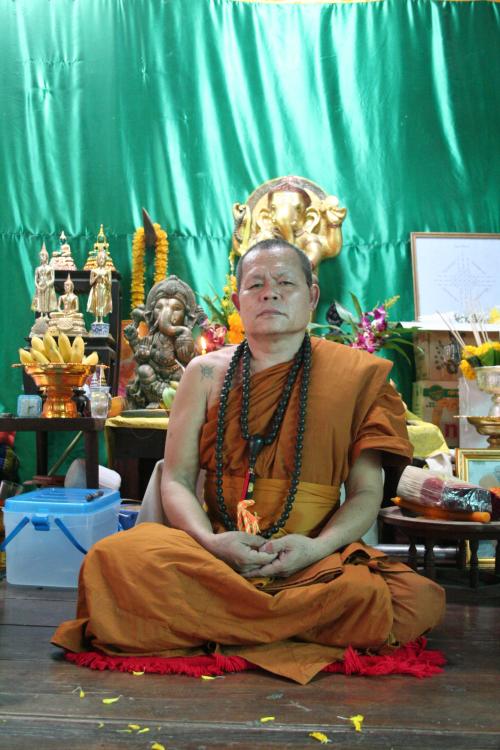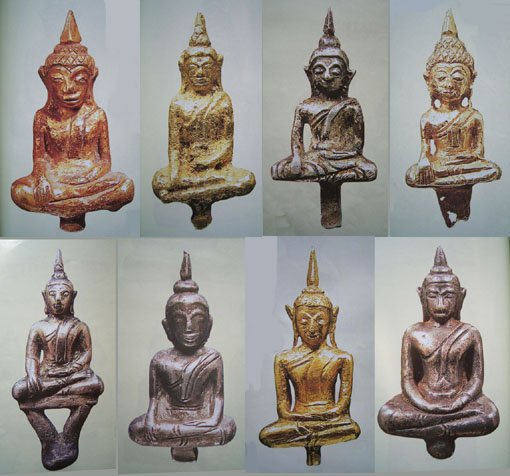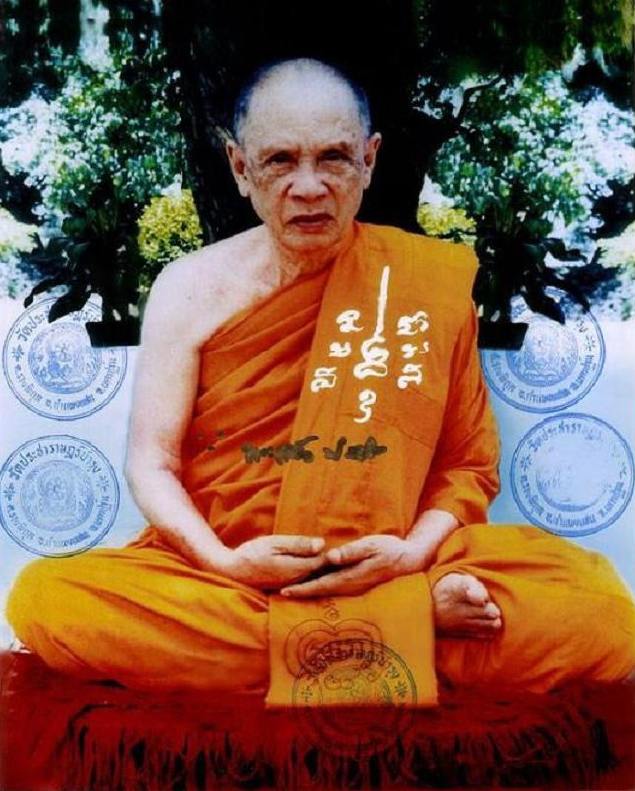Welcome to our store Uncle Chow Amulet Gallery
Archives
Biography – Luang Pu Tim (Wat Lahanrai)

unclechow.com – Who is the venerable monk Luang Pu Tim of Wat Lahanrai ( Ban Khai District, Rayong, Thailand)?
About LP Tim – Wat Lahanrai
Luang Pu Tim was born in Ban Hua Tunnttabuon, Tambon Laharn, Ampher Bannkaii, Jungwat Rayong on the 16th June BE 2422 in the year of the Rabbit.
He was named Tim, and his family name was Ngamsii. At the age of 17 his father, Kheh, sent to Tan Phor Singh to study, returning home at the age of 19 and was ordained as a monk at Wat Thatkaow on the 7th June BE 2499.
He was ordained by Phrakru Kaow, Archan Singh and Archan Kehh and was given the religious name of Issaliko. After spending a year in Wat Thatkaow, he retreated in the forest for a period of three years, after which he went to Wat Narmathom in Chengwat Chonburi for two years.
Luang Pu Tim learned Wijja (magic) with Ajahan Lod, Ajahn Lem and Ajahn Saii. He also studied with his Uncle Luang Phor Song Thao of Wat Kongchin. It was from this uncle that Luang Pu Tim inherited a book of Wicha and Arkom. Luang Pu Tim became the Abbot of Wat Lahanrai where he was a strict and diligent practioner of the Dhamma.
He was known to be a very good monk and possessed few worldly materials. In the hut where he stayed, he only had a pillow and a mat with no electricity. He lived a simple life. He passed away on the 18th October BE 2518 having spent 72 years in the Sangha.
Phra Khun Paen Plai Kuman
Phra Khun Paen Plai Kuman is one of the most famous amulets created by Luang Pu Tim of Wat Lahanrai. His amulets are very popular and expensive but for good reason.
A popular account has been well publicized around the internet. This is an updated and somewhat more accurate version.
Phra Khun Paen Pong Plai Kuman of Luang Pu Tim Isarigo, a senior monk of Wat Lahanrai, Rayong province, is respected as one of the most sacred amulets consecrated in modern times.
A genuine Phra Khun Paen Plai Kuman amulet is probably the hardest to find, and fakes abound everywhere. This amulet is well proven in Metta Mahaniyom, Metta, Mahahsaneh, business success and almost all that you wish to do.
The actual methods used to create this amulet follow the ancient traditional ways. Only a few guru monks are known this century to be able to create such an amulet, namely Luang Pu Tim himself, and Luang Phor Tae of Wat Sahm Ngam.
The most popular series of the Phra Khun Paen Pong Plai Kuman amulets are known as the first series (often called “the first block”) containing both Pim Yai and Pim Lek, some with sacred takruts and others without.
It is generally believed that Luang Pu Tim had asked a disciple to make the amulets for him and on a daily basis he would bring newly made amulets to the temple and then Luang Pu Tim would gradually recite the sacred spell for each and every amulet.
Indeed it was recorded that 30-40 of the Pim Yai amulets and around 100-200 of the Pim Lek amulets were brought to him daily.
The disciple responsible for making the amulets was known to have stated that only a single mold was created for both the Pim Lek and the Pim Yai amulets. Luang Pu Tim did not make further molds and as such it’s highly likely that only a single series of these amulets were ever created.
Many dealers may claim to possess amulets that have originated from different series, but be warned you are most likely being deceived.
One of the reasons that such a low quantity of these amulets were produced was no doubt due to the difficulty and danger associated in production. As stated previously it was well known among experts of the black magic sciences that only a few monks possessed the arcane knowledge required to produce such an amulet.
If lesser persons attempted such a process it is highly likely that they would themselves become possessed with demonic spirits or harmed in some way. Luang Phor Tae of Wat Sam Nagm was the only other living monk who possessed the knowledge.
Mr. Lap Choicharoen, a close disciple of Luang Pu Tim had said that he was instructed to locate the corpse of a pregnant woman who had passed the cremation ceremony on a Tuesday.
Furthermore he was to bring the burnt head bone of the dead foetus to Luang Pu Tim. This was required in order to create the sacred powders used in the preparation of the Phra Khun Paen Pong Plai Kuman amulets.
Luang Pu Tim chanted a special black magic spell or Katha for one week in order to control the soul and also prevent the spirit departing from the Plai Kuman.
Once completed, his disciple was instructed to pound and grind the material into very fine powder, which he commenced to do. It was not long however that he became somewhat disturbed by sparks emanating from the mortar. He had to burn incense and ask for forgiveness before this phenomena abated.
Luang Pu Tim took the Plai Kuman powder and mixed it with a number of other sacred powders including, Itijeaepattamung powder, Jindahmanee powder, Prawai and 108 different herbs and sedges. The mixture was chanted for days on end before being pressed into the molds.
The Pim Yai amulet is 3.5 cm in length and 2cm in width. The amulet face features Buddha sitting in Samadhi, to his left and right are two Nang Kwak in prayer.
On the reverse is the famous Luang Pu Tim Yant Har, representing five previous Buddha’s. Certain Pim Yai, mostly the Neua Khao versions, have a pair of takruts inserted and a layer of gold paint applied.
A total of 2,000 pieces were created and chanted, some with and some without the takruts.
Once his disciple questioned Luang Pu Tim on the reason why he chose to use the skull of a dead child in the process. He was answered
“When we plant a tree, we want to eat the fruits quickly. This is similar to wearing an amulet. We want the amulet to provide merit and protection. The Phra Khun Paen Plai Kuman amulet will provide merit from Lord Buddha and the power and protection will come from the Plai Kuman”
The Pim Lek is slightly smaller in dimension being 2cm in height and 1cm in width. The amulet face features Buddha sitting in the full lotus position, below which is a sleeping Guman Thong. To the left and right are two Nang Kwak, believed to impart Metta Maha Saneh (loving kindness). The reverse of the amulet once again features the 5 Yant inscription.
A total of 5,000 pieces were created with 20 pieces made with Wahn Maha Saneh and Dtoktorng powders. These powders are considered special and generally difficult to find. Clearly these versions of the amulet, being the rarest, are by far the most expensive (generally yellow in colour).
The colour of the amulets varies depending on the final mixes of the scared powders used, and the varying degrees of pressure used in the molding process.
Particular amulets when viewed under magnification even show signs of their origin, often containing fingernails and hair.
The Plai Kuman was also added to other batches of amulets, namely; Phra Nangphya, Phra Plaai Buar, Phra Pitda, Phra Kring Chinabahnchorn and Phra Somdej. In the case of the Phra Kring amulet the material was added to the base.


